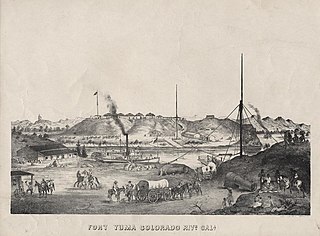Related Research Articles
The Yuma Expedition was a U.S. Army military operation from 8 February 1852, to October, 1852 in the Yuma War.

Fort Yuma was a fort in California located in Imperial County, across the Colorado River from Yuma, Arizona. It was on the Butterfield Overland Mail route from 1858 until 1861 and was abandoned May 16, 1883, and transferred to the Department of the Interior. The Fort Yuma Indian School and the Saint Thomas Yuma Indian Mission now occupy the site. It is one of the "associated sites" listed as Yuma Crossing and Associated Sites on the National Register of Historic Places in the Yuma Crossing National Heritage Area. In addition, it is registered as California Historical Landmark #806.

Port Isabel was a seaport established on Port Isabel Slough in 1865 during the American Civil War in Sonora, Mexico in the mouth of the Colorado River on the Gulf of California. It was founded to support the increased river traffic caused by the gold rush that began in 1862 on the Colorado River and the Yuma Quartermaster Depot newly established in 1864 to support the Army posts in the Arizona Military District. The slough was discovered in 1865 by the Captain W. H. Pierson of the schooner Isabel, that first used the slough to transfer its cargo to steamboats safe from the tidal bore of the Colorado River. Shortly afterward Port Isabel was established 3 miles up the slough and replaced Robinson's Landing as the place where cargo was unloaded in the river from seagoing craft on to flat bottomed steamboats of the Colorado River and carried up to Fort Yuma and points further north on the river.
George Alonzo Johnson (1824–1903) 49er, entrepreneur, and California politician.

Steamboats on the Colorado River operated from the river mouth at the Colorado River Delta on the Gulf of California in Mexico, up to the Virgin River on the Lower Colorado River Valley in the Southwestern United States from 1852 until 1909, when the construction of the Laguna Dam was completed. The shallow draft paddle steamers were found to be the most economical way to ship goods between the Pacific Ocean ports and settlements and mines along the lower river, putting in at landings in Sonora state, Baja California Territory, California state, Arizona Territory, New Mexico Territory, and Nevada state. They remained the primary means of transportation of freight until the advent of the more economical railroads began cutting away at their business from 1878 when the first line entered Arizona Territory.
James Turnbull was the first steamboat captain on the Colorado River. His voyages supplying the Army at Fort Yuma demonstrated that the river was navigable by steamboats.
Invincible was a 120-ton topsail schooner, used as a transport for the U. S. Army Department of the Pacific in California from 1849 to 1851.
Uncle Sam, was a side-wheel paddle steamer and the first steamboat on the Colorado River in 1852.
Explorer was a small, custom-made stern-wheel steamboat built for Second lieutenant Joseph Christmas Ives and used by him to carry the U. S. Army Corps of Topographical Engineers expedition to explore the Colorado River above Fort Yuma in 1858.
Colorado, was a stern-wheel paddle-steamer, the third steamboat on the Colorado River, and first stern-wheel steamboat put on that river, in December 1855.
Cocopah, was a stern-wheel paddle-steamer, the fifth steamboat on the Colorado River, first put on the river in August 1859.
General Jesup was a side-wheel paddle-steamer, named for General Thomas Jesup then Quartermaster General of the United States Army, and was the second steamboat launched on the Colorado River, in 1854.

Colorado, second of its name on the Colorado River, was a stern-wheel paddle-steamer, rebuilt from the original Colorado was the fifth steamboat on the Colorado River. It was first put on the river in December 1862.
Esmerelda, was a stern-wheel paddle-steamer, built for the Sacramento River trade, in 1864 it became the first of the opposition steamboats on the Colorado River. It was also the first steamboat to tow large cargo barges on that river, in May 1864 and to reach Callville, Nevada in 1866.
Benjamin Minturn Hartshorne (1826–1900) was a California businessman who immigrated during the California Gold Rush. He was involved in Sacramento River and Colorado River steamboats as well as maritime shipping.
Mohave was the first stern-wheel steamboat of that name running on the Colorado River between 1864 and 1875.
Alfred Henry Wilcox (1823-1883), sea captain, later Colorado River pioneer and steamboat and steamship entrepreneur, partner in the George A. Johnson & Company and of the Colorado Steam Navigation Company, banker and director of the California & Mexican Steam Ship Line.
George A. Johnson & Company was a partnership between three men who pioneered navigation on the Colorado River. Benjamin M. Hartshorne, George Alonzo Johnson and Alfred H. Wilcox. The George A. Johnson & Company was formed in the fall of 1852, and was reorganized as the Colorado Steam Navigation Company in 1869.
Port Isabel Slough was a deep slough in the Colorado River Delta near the mouth of the Colorado River during the 19th century, within the state of Sonora, Mexico.
Sierra Nevada was a schooner, used as a transport for the U. S. Army Department of the Pacific in California to carry supplies for Fort Yuma to the mouth of the Colorado River in 1853-1854.
References
- ↑ The Maritime Heritage Project; Ships arriving at the Port of San Francisco; Arrivals 1852 from maritimeheritage.org, accessed November 30, 2014
- ↑ Richard E. Lingenfelter, Steamboats on the Colorado River, 1852-1916, University of Arizona Press, Tucson, 1978, p.9,11